When people run a search, what are they really looking for?
The landscape of search has transformed considerably over the past decade, with semantic web technology emerging prominently from it. Users now expect search engines to understand natural language more comprehensively than ever before. And indeed, Google has meaningfully succeeded with language processing and understanding the user intent behind queries.
In the old days, when search engines weren’t as advanced as they are today, finding precise answers to queries in a single click was a rarity. For instance, a search for “MySpace vs Facebook”, would probably lead users directly to these websites instead of providing a clear comparison between the two.
What do we have now?
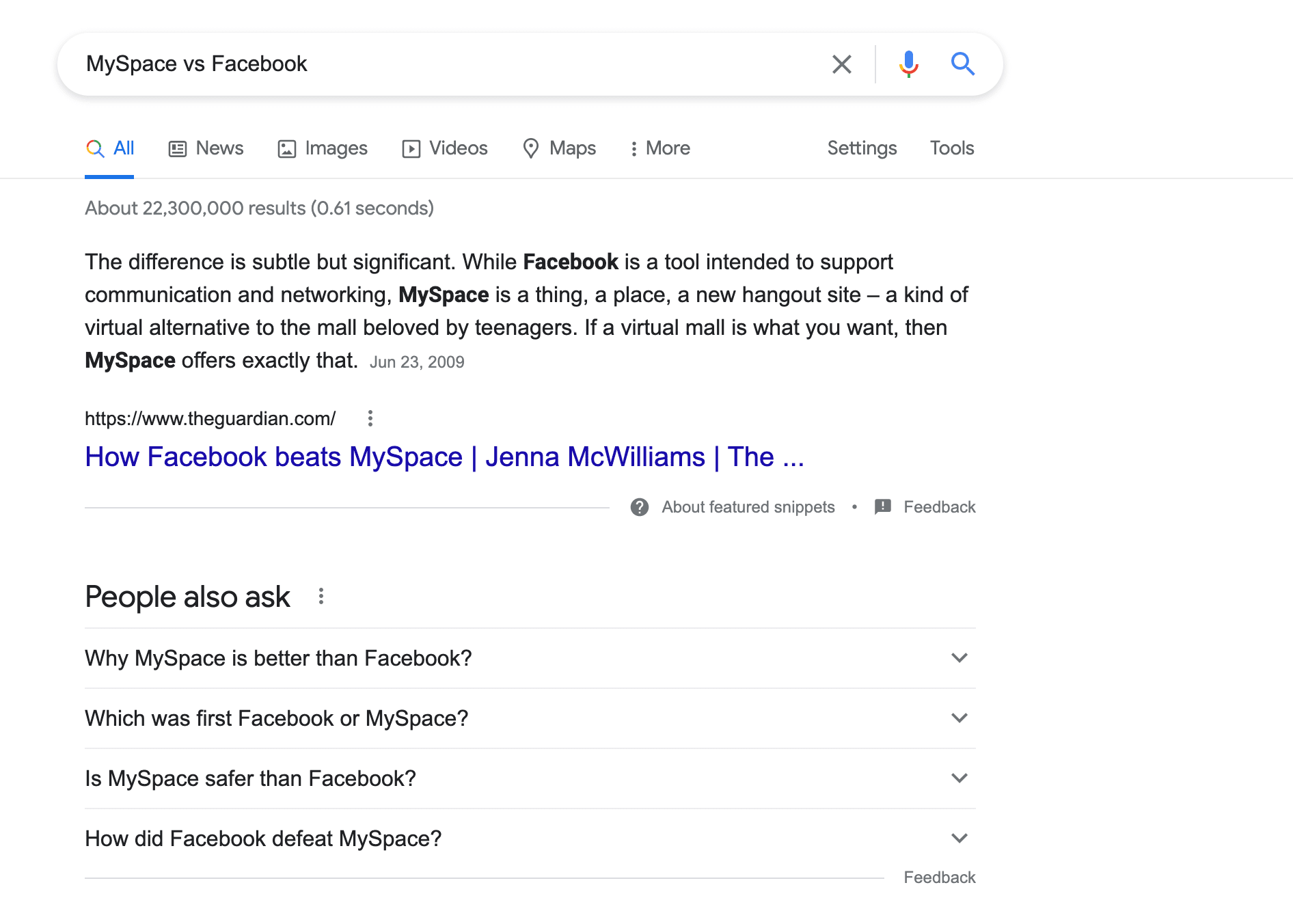
Google doesn’t just recognize the keywords “MySpace”, “vs”, and “Facebook.” It also attempts to deliver the most precise results by translating the user intent behind the entire phrase. The end result is a featured snippet that explains how the two social networks differ from each other.
Google’s end goal is to provide the most relevant results to searchers.
Getting to know Semantic SEO
Semantic SEO is the process of optimizing your content for a topic instead of for a single keyword or phrase. It considers factors such as user intent, user experience and the relationships between entities and concepts. This approach helps search engines deliver more meaningful results and enhances the overall user experience in search.
Semantic SEO, at its core, is about creating comprehensive content with all the necessary information for a specific topic.
The impact of AI and NLP on today’s SEO
To create compelling content and optimize a website for visibility in search results, it is crucial to grasp Google’s current approaches to ranking websites and displaying information on SERPs.
The first (and most important) thing to remember is that Google has been actively pursuing a more human-like and semantic approach to understanding and ranking content.
Let’s take a detailed look at some of the biggest turning points in this evolution:
- Knowledge Graph: Since 2012, Google has used this large and sophisticated knowledge base to help crawlers understand the relationships between various entities and concepts.
- Hummingbird: In 2013, Google released an algorithm update that helps it better understand the meaning and context behind entire queries, minimizing its emphasis on distinct words.
- RankBrain: Since 2015, this machine learning algorithm helped Google better interpret search intent and provided users with more relevant search results.
- BERT: In 2019, Google introduced a groundbreaking technology that greatly enhanced search intent and conversational search. It emphasized what were previously considered “less important words” like conjunctions and their placements within queries. For instance, before BERT, a query like “British traveler to USA need a visa” likely wouldn’t have placed enough emphasis on the word “to.” It would have provided you with US-centric results rather than relevant info for a British traveler. These days, the intent is better understood, resulting in more helpful SERPs.
But 2023, as you will see, marks an unprecedented breakthrough in Google search. On May 10, 2023, Google announced that it was finally ready to reimagine the traditional search experience using generative AI. This is when the search engine began its testing phase for Search Generative Experience, a feature that generates interactive AI snippets at the top of the SERP. These dynamic snippets offer users verified answers to their queries and include links to relevant sources, with up to three visible at a time.
Currently, SGE is only available in English and limited to users in the United States. It’s worth noting that the selection of websites for the AI snippets is not solely based on high rankings; rather, SGE focuses on websites that present the exact perspective it seeks.
That is to say, with these new generative AI capabilities incorporated into search, users will be able to learn about a topic faster, uncover new viewpoints and insights, and accomplish tasks with greater ease.
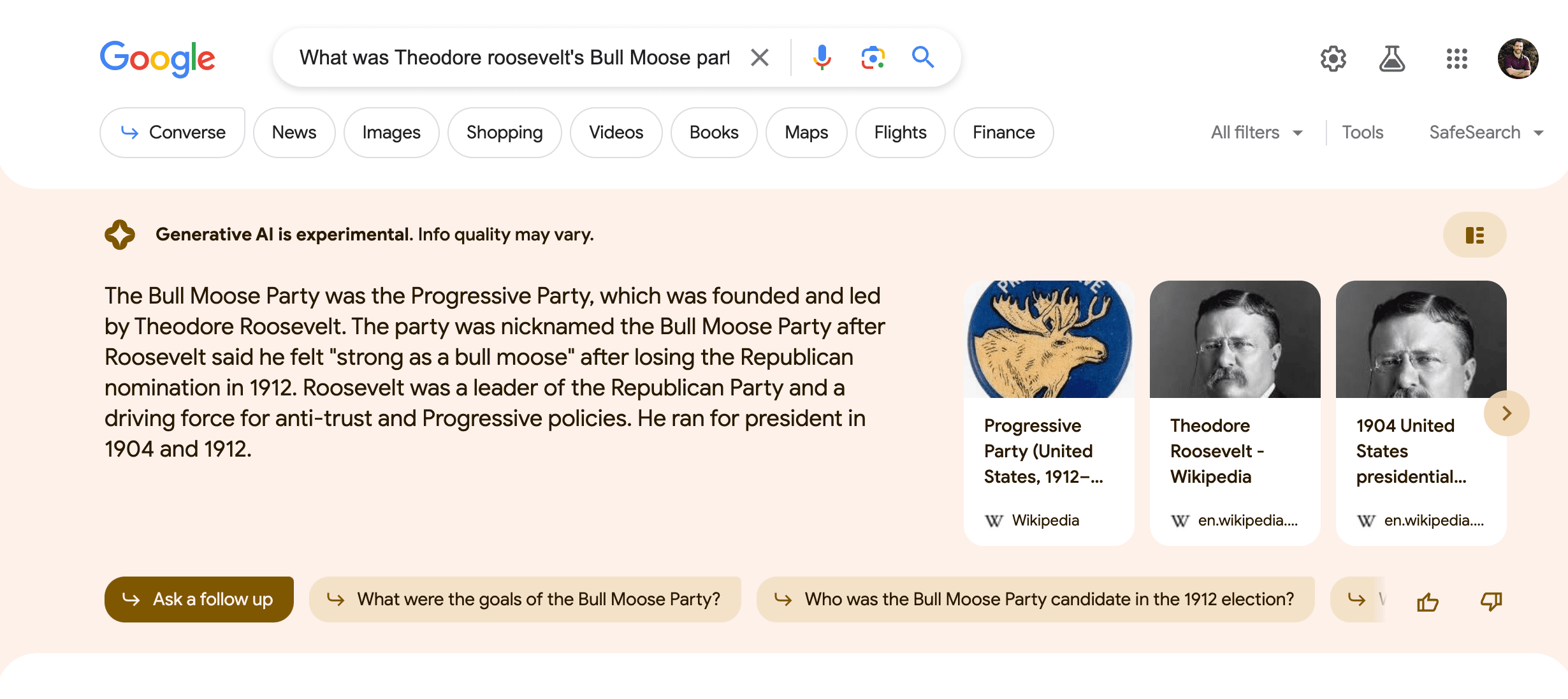
But this is not the end of Google’s experiments with artificial intelligence. Let’s take a closer look at Bard, Google’s latest conversational generative AI chatbot. Bard was created in direct response to the popularity of OpenAI’s well-known ChatGPT and was initially released at limited capacity in March 2023. Today, you have the option to use Bard as a chatbot, in which case it will answer your questions, or you can use it as an assistant to help you accomplish various tasks.
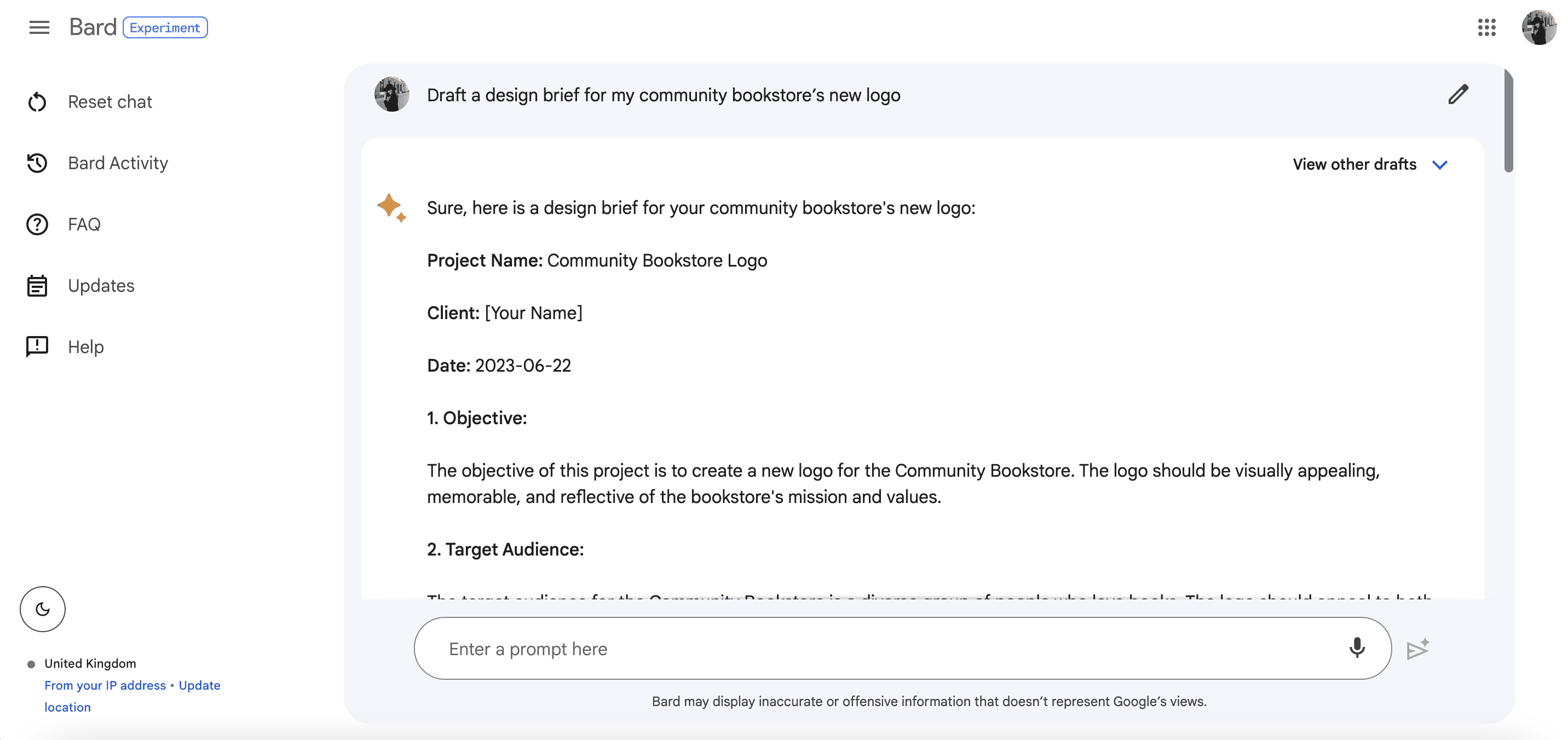
Google has future plans to incorporate Bard into its Knowledge Graph Cards feature. While a Knowledge Graph provides word definitions or overviews of individuals or locations, Bard’s responses are designed to address questions that do not have a single correct or definitive answer. Bard actually provides nuanced and contextual responses.
In the context of semantic SEO, it is also worth considering the widespread emergence of Natural Language Processing. NLP plays a significant role in helping Google rank websites. It drastically improves Google’s understanding of web content and user queries.
Here are some ways in which NLP contributes to Google’s website ranking process:
- Content Analysis: By using NLP techniques to examine the text, Google can extract important keywords, identify entities (such as people, places, and organizations), and determine the overall theme and topic of a page.
- Query Understanding: By analyzing the language used in search queries, Google can identify user intent and deliver more relevant search results.
- Semantic Search: NLP enables Google to move beyond mere keyword matching and comprehend the meaning of words and phrases within a broader context. This allows Google to grasp the relationships between words and deduce the intent behind complex queries.
- Natural Language Generation: Although not directly related to website ranking, Google employs NLP to generate featured snippets, knowledge panels, and other informative elements in search results.
AI and NLP are taking the tech world by storm. In fact, they have already drastically transformed SEO by enabling search engines to understand user intent deeply and deliver relevant results with unprecedented accuracy. The SEO specialists of today need to adapt their strategies to align with these growing advancements in tech. They can do this by focusing on high-quality content, user experience, and forming a deep understanding of natural language.
Semantic SEO and entities
One of the key aspects of Semantic SEO is the concept of entities.
Entities can be individuals, places, organizations, concepts, or any distinct object or idea that holds meaning.
By incorporating entities into search algorithms, search engines can gain a deeper understanding of the relationships between different entities and the context in which they appear. This capability enables search engines to provide more precise, comprehensive and relevant search results.
Entities allow search engines to transcend literal keyword matching and grasp the intent behind a search query. For example, if a user enters a request containing “apple”, search engines can accurately determine whether the user is referring to the company or the fruit based on the context and other related entities in the query.
To organize entities and their interrelationships, Google uses a framework known as the Knowledge Graph. Here’s what it looks like:
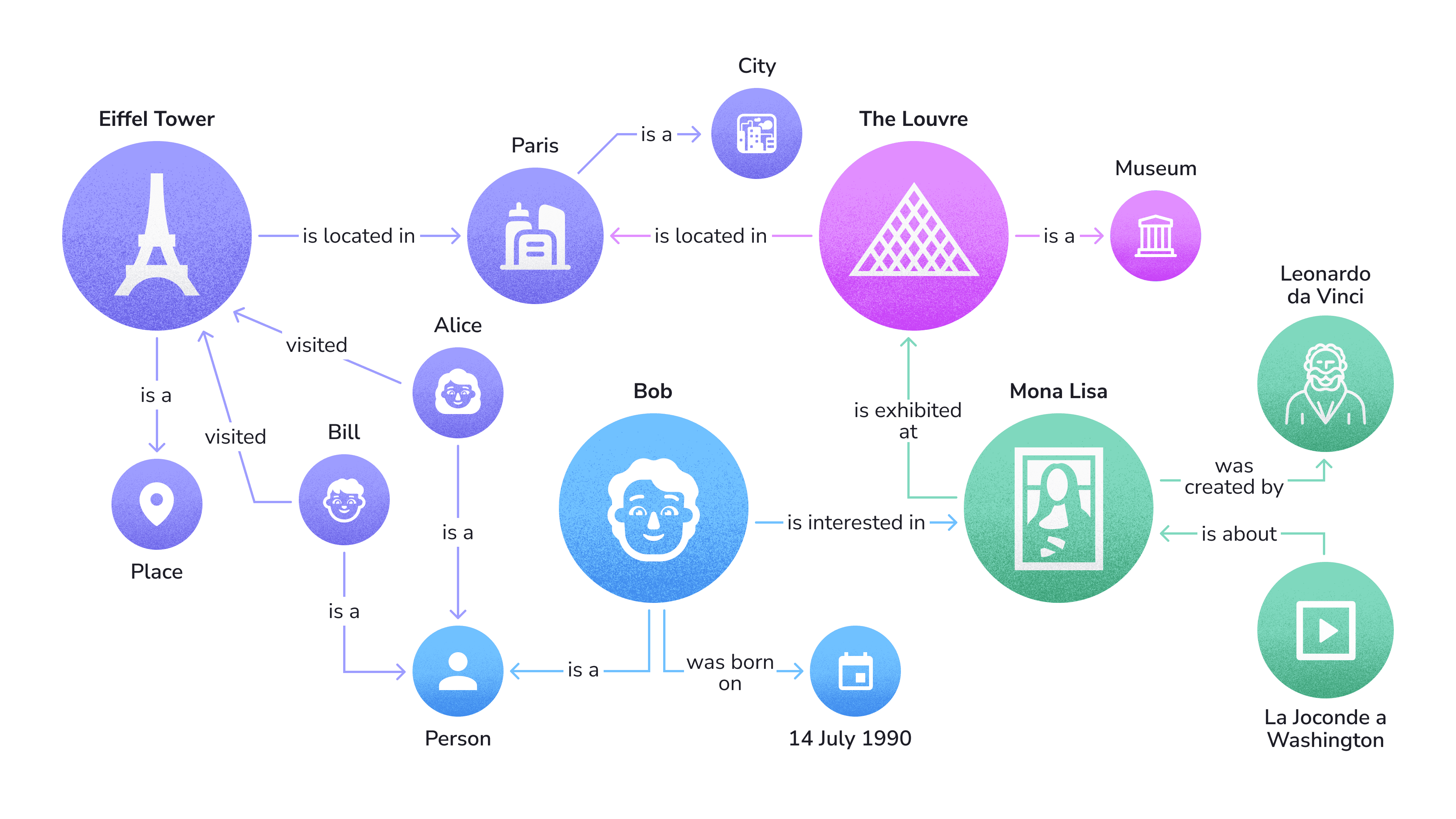
From an SEO perspective, grasping the concept of entities is crucial for optimizing website content. By incorporating relevant entities into website content, meta tags, and structured data markup, webmasters can provide search engines with valuable context regarding their content. This helps search engines understand the subject matter and accurately gauge the relevance of the content. This leads to better rankings and visibility in search results.
And with the rise of voice search and natural language processing, entities have become even more important. Voice queries often involve conversational language and context, and entities play a vital role in effectively interpreting and responding to these queries.
Some believe Google has already shifted its focus from mobile-first indexing, which prioritizes URLs, to entity-first indexing, which prioritizes the hierarchy of entities within the knowledge graph.
Why is semantic SEO important?
By adopting semantic SEO practices, you can future-proof your SEO strategy and stay ahead of algorithm updates. If you focus on optimizing content not just for specific keywords but also for the overall topic and user intent, you can reap the following benefits:
- Your content will rank higher. Semantic SEO helps search engines understand the content of web pages more accurately. By providing search engines with structured data markup, and relevant semantic signals, your website is more likely to rank higher in relevant search results, increasing your overall search visibility.
- You will rank for more keywords. By going beyond individual keywords and focusing on the broader context and intent of search queries, Semantic SEO allows you to target a wider range of related keywords. Understanding the relationships between different terms and concepts allows you to create content that aligns with user intent, capturing more organic search traffic and expanding your keyword reach.
- You will send quality signals to Google. Google understands that people may sometimes make life-altering decisions based on what they read online. This is why the search engine strives to provide accurate, truthful, safe, and useful information to searchers. By maintaining accurate and up-to-date content, fully disclosing the topic, and meeting Google’s E-E-A-T criteria, you can establish your page as high-quality in Google’s perspective, leading to higher rankings.
- Your content will show up in SERP features. By utilizing structured data, you can establish semantic relationships that can enhance your search engine result page listings. Rich snippets, such as star ratings, reviews, images, pricing information, and other relevant data, can make your listings more eye-catching and informative. Your content might also be shown in SERP features like the People Also Ask block, providing concise answers to user queries and driving more qualified traffic to your website.
- Your visitors will stay on your website longer. Semantic SEO focuses on delivering more meaningful and relevant search results to users. By understanding user intent and providing precise answers or content that matches their needs, you can improve your website’s overall user experience on your website. Users will spend more time studying your page content if they find it appealing. This leads to higher user engagement, longer time spent on your site, and increased conversions.
By embracing semantic SEO practices, you can optimize your website for the evolving search landscape, drive more organic traffic, engage users more effectively, and ultimately achieve your online business goals.
Semantic SEO best practices
In the old-school SEO, you could choose a keyphrase, use it in your title/description, headers, and through the text, and hopefully, rank for this keyphrase. However, with the development of semantic search, the game has become more challenging, particularly for webmasters.
Fili Wiese, a technical SEO consultant at SearchBrothers and ex-Google engineer, suggests taking a more comprehensive approach.

To use semantic SEO properly, you can roughly divide your work into three stages: keyword research, content creation and optimization stages.
Semantic keyword research
In the first stage, you focus on choosing a topic based on user intent and collecting a list of relevant keywords.
Your action plan for this stage is as follows:
- Create a keyword list. Compile a list of related keyphrases and LSI keywords that are semantically related to your target keyphrase.
- Identify long-tail keywords: Identify specific long-tail keywords that address your topic and have a clear intent.
- Structure the keyword list: Organize your keyword list by combining similar queries into groups, also known as keyword clustering, or grouping.
Use Google to create a keyword list
While you should not rob yourself by drawing keyword ideas solely from Google, it is definitely the right place to start.
To kick things off, think of the keywords you want to rank for in Google. Let’s say you run a yoga studio in LA. You definitely want to rank for such commercial keywords as “yoga school” or “yoga studio LA”, but you also want your blog to rank for all sorts of informational keywords like “downward-facing dog” or “meditation techniques”. And here’s how you can find all of the most popular queries.
The moment you start typing “yoga” in the Google search bar, you’ll see a number of suggestions. They are all a mix of keywords that are trending on Google and the search terms Google believes you’ll be interested in based on your search history.
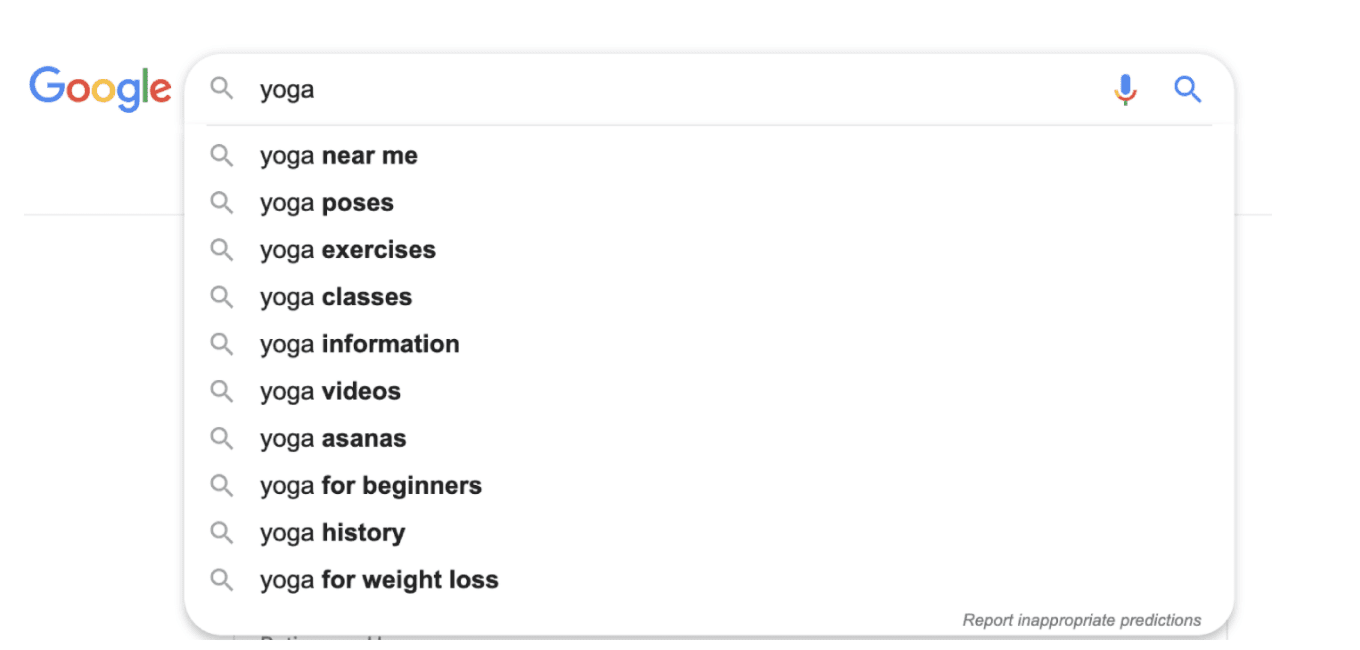
Don’t forget to add long-tail keywords to your list. These are usually well-considered queries that are used in the form of questions and sentences.
Consult the section “People also ask” and use those queries in Google search to check what autocomplete results it will bring.
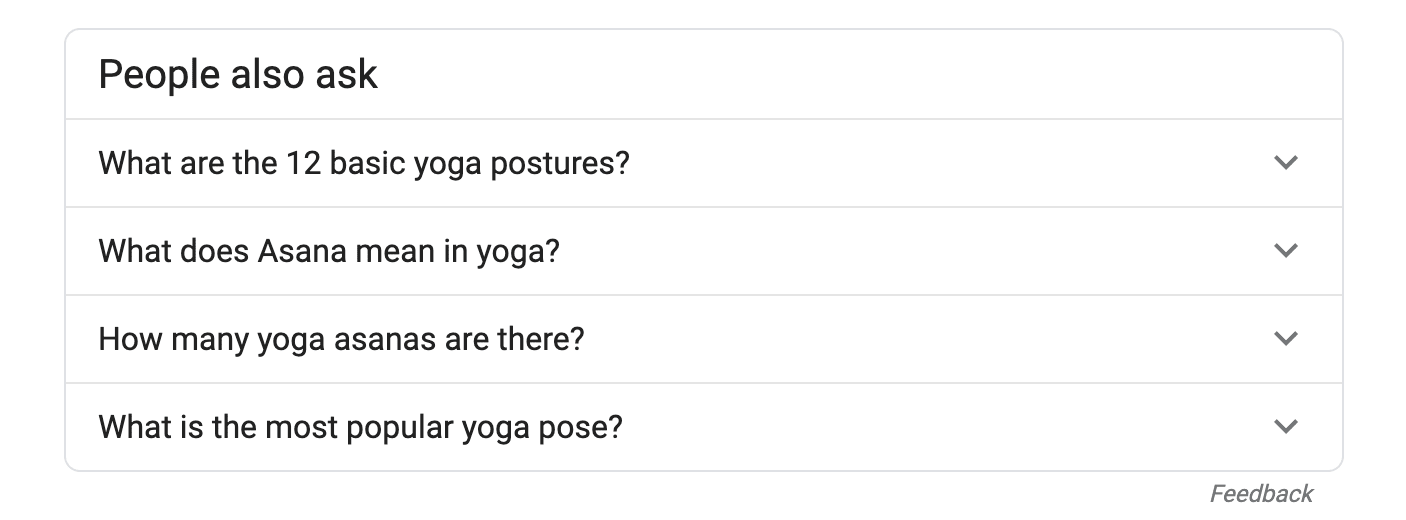
Or, scroll down to the bottom of Google page one and find a list of related search queries that can also bring you the ideas of long-tail keywords.

Google Search also allows looking for synonyms and LSI keywords. They are often confused with one another; however, not all related search terms can be synonyms.
For example, “yoga asana” and “yoga pose” are synonyms, whereas “yoga class” is related to the previous phrases but has a separate meaning.
You can find some synonyms and LSI phrases with the help of the autocomplete feature or in the related searches at the bottom of the SERP.
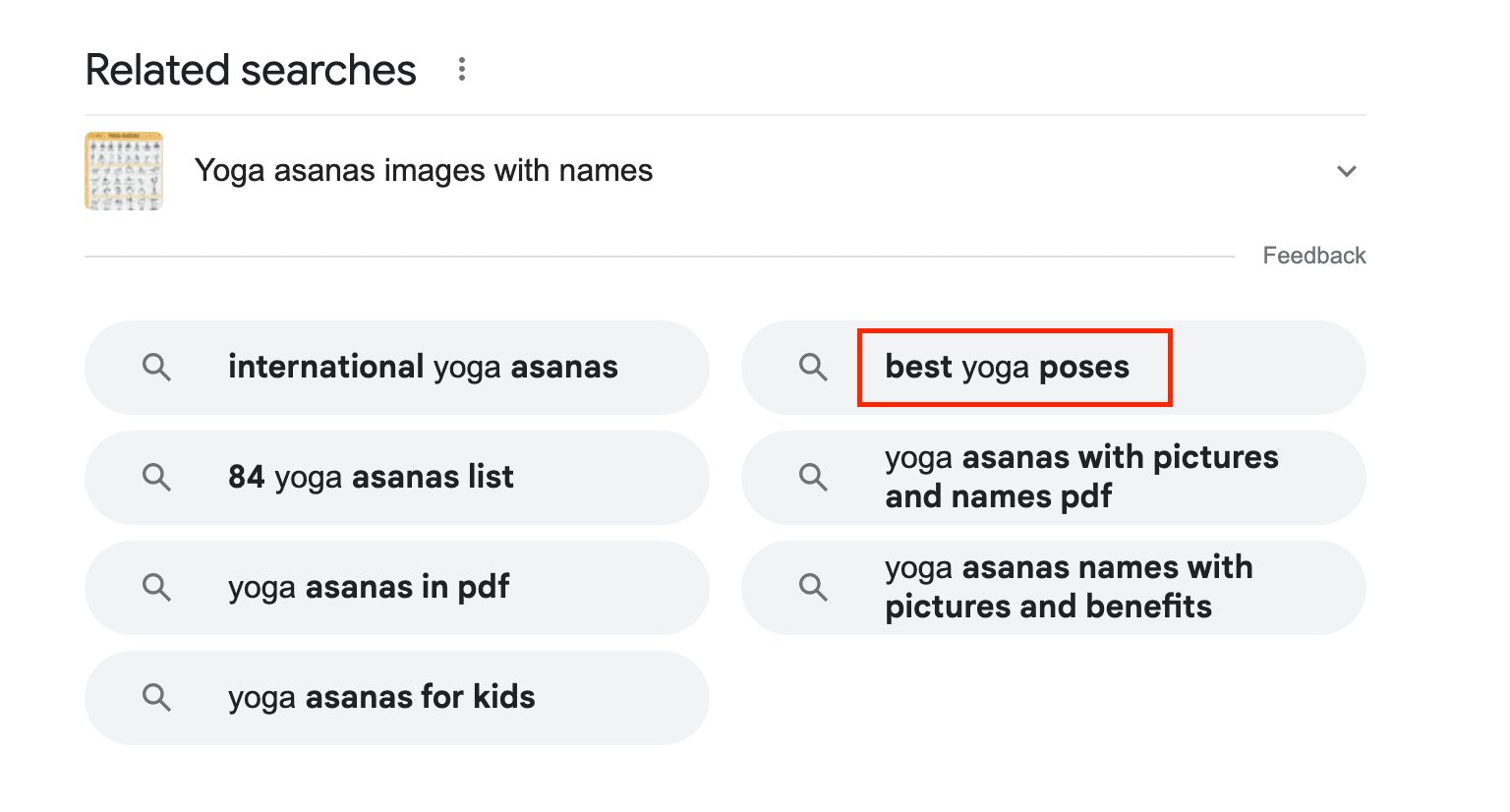
You can go on and on this way to gather all the queries Google has to offer. And maybe looking at these keywords will help you come up with some more ideas of related queries of your own.
While using Google is a surefire and old-school way of collecting semantic data, you can also speed things up and get better results with specialized semantic SEO software.
Search for keywords with SE Ranking
SE Ranking’s Keyword Planner boasts a huge database that goes beyond search engine suggestions. It hosts over 4 billion unique search queries, which means you can have thousands of keyword ideas generated in one click.
For every keyword, you can see plenty of metrics, including the keyword’s Google search volume—the number of searches the keyword gets each month. The yoga topic, for example, has 450K monthly searches.

You can use filters to leave out keywords that you don’t feel like taking on. For example, you can filter out keywords with a really high search volume, which as a rule are too vague and overly competitive.
For even more ideas, check the Related, Questions and Low-search volume tabs. While the Similar keywords tab only features search terms containing variations of your seed keyword, the Related keywords tab presents a wide range of semantically related queries.
Finally, SE Ranking allows you to easily draw keyword ideas from your competitors. You don’t even need to choose which competitor to analyze—the Competitor Research tool will identify your major SEO rivals and will come up with a list of keywords your competitors rank for while you don’t. That way, you can discover some not-so-obvious topics related to your business niche.
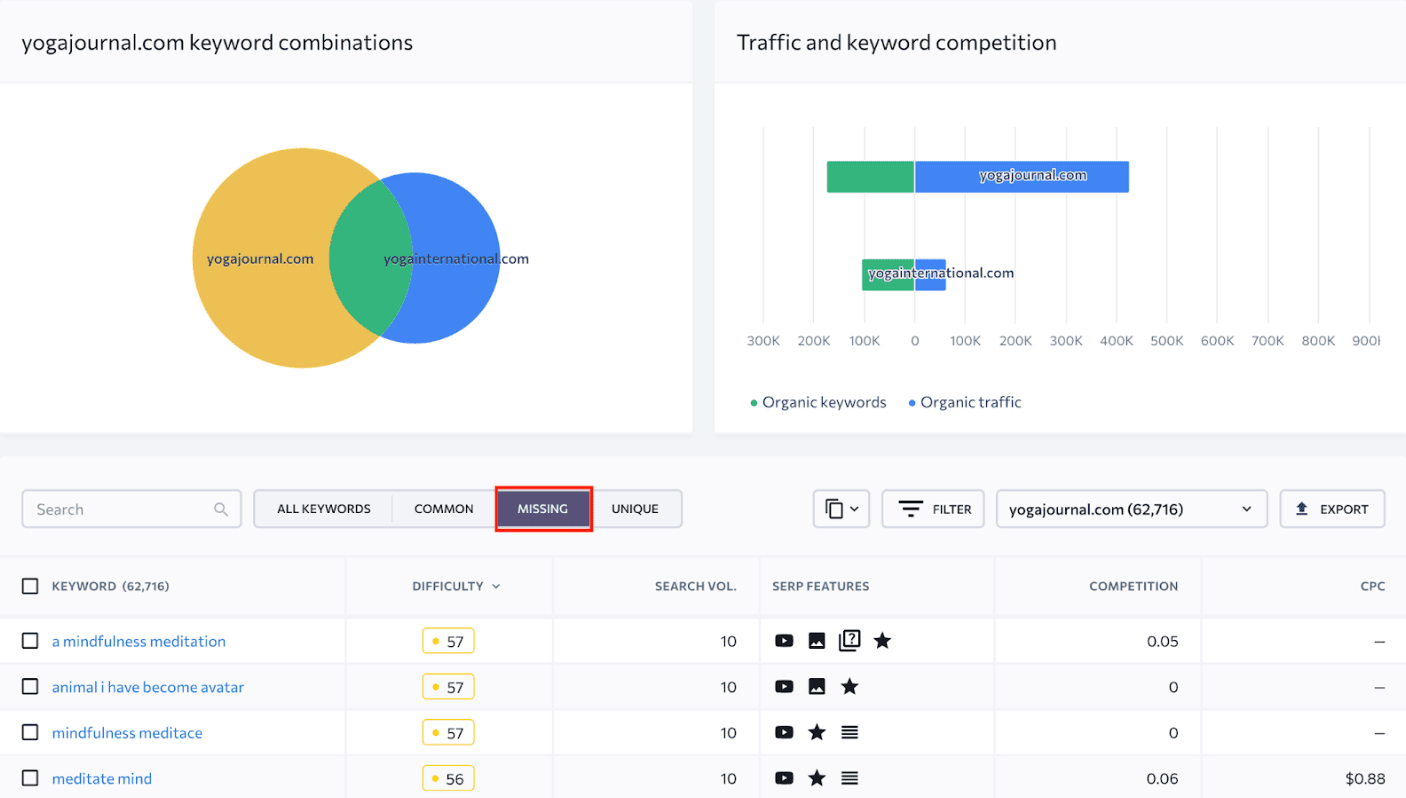
Cluster all your keywords
Once you’ve collected keywords from all possible sources and compiled everything together in a spreadsheet, your next step is to remove any duplicates and move on to keyword clustering.
Look at your list and think of ways to categorize keywords into different groups.
For example, let’s say you have a long list of keywords about “yoga asanas”.
Here are some ways to group them:
- By their semantics: “yoga poses”, “yoga postures”, “asanas list”, etc.
- By user intent: “how to do yoga asanas”, “what are the beginner yoga poses”, etc.
- By search volume: high-volume keywords versus low-volume keywords, etc.
Grouping keywords by search volume specifically can help you develop your site’s structure. It’s best to think of high-volume keywords as categories, and low-volume keywords as potential article topics or service/product pages.
Semantic search engine optimization entails creating content clusters based on topics rather than keywords. Using the pillar cluster model, content hub and topic maps can help you group content according to semantic SEO principles.
To apply the pillar cluster model, group keywords by topics for your future pages. This method involves grouping topics in a manner where more specific subtopics complement a broader main topic. This allows you to group keywords around a specific topic while breaking them into many distinct pages. Topic clusters help search engine bots comprehend each page’s context, relationships, and hierarchy within a particular content framework.
Once you have grouped keywords by their main themes and their supporting subtopics, you can efficiently organize them on your website using the content hub method. Content hubs serve as a collection of all your content related to a specific subject, designed to be a comprehensive resource on that topic. The hub comprises the pillar page, which focuses on the most general aspect of the main topic, and additional thematic pages that delve into specific aspects of the overall theme. These pages are connected with hyperlinks.

Another method for clustering your keywords and structuring your content is topic mapping. This is similar to the knowledge graph, where pages are grouped and linked based on associations that represent the relationships between topics. Unlike the pillar and content hub methods, there is no distinction between the main content and supporting content. This approach is designed to connect topics in a semantically meaningful way.

But each of these cluster methods will, in their own unique way, help you structure your content while also avoiding keyword cannibalization.
That’s it for traditional keyword research and clustering. You can gather ideas from search engines or use SE Ranking to speed things up, adding new topics to your content plan and grouping pages by theme.
Content creation
Now that you have successfully compiled all your keywords and topics, let’s look at how to write content while considering the role of semantic search.
Use semantic markup
Using semantic markup is just as critical for rankings as performing careful keyword research.
Semantic markup, or in other words, semantic HTML, is a set of elements that clearly defines the structure of your content and gives meaning to it.
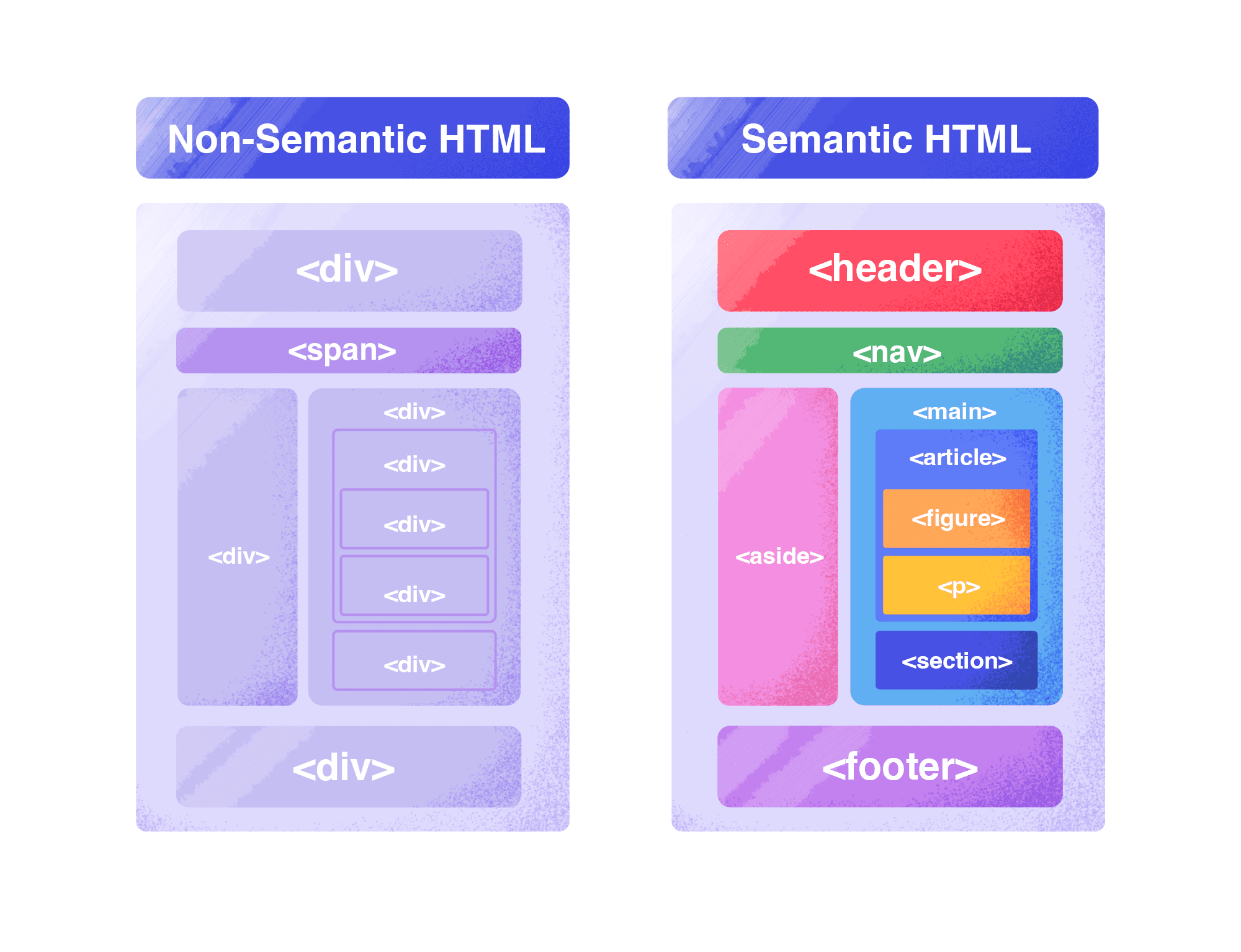
For example, an <h1> tag indicates that the embedded phrase is the title of your article. This is both presentational and semantic markup, as you show users and search engines where the title is.
Examples of semantic HTML tags include:
- <h1> through <h6>
- <blockquote>
- <form>
- <table>
- etc.
With the help of semantic elements, some parts of your content, like lists, can show up as a featured snippet.
Make your content richer, not longer
Simply stuffing your content with the right keywords won’t cut it anymore, your content has to meet users’ intent to rank high. The key is to think about the topic, not just keywords. And your task is to properly interpret these keywords to best address your customers’ needs.
Here’s what Lee Wallis, Head of Digital at Excite Media, Winner for SEO—Australian Web Awards 2021, suggests:

That being said, you need to ensure that you are focusing on different aspects of the topic in order to make your content richer and provide additional value to the user. This in turn will help search engines better understand your page anyway. One tip for doing this is by developing a list of the most common questions about the topic and using this as a guideline for writing the page.
Creating additional pages to expand on your topic is also a great way to provide more context to the search engines while at the same time offering more value to your website visitors.
Whenever possible, try to prioritize evergreen content.
Use special tools to learn how to optimize your content
To enhance your semantic writing process and increase your chances of success in the competitive online landscape, you can use specialized content tools. There are tons of content tools that can save you time and money simply by generating text and optimizing it for search. We’ll go over how to utilize them, using SE Ranking’s Content Creation Tool as an example.
Begin by analyzing SERP content. The tool observes top competitors to determine the recommended number of words, headings, paragraphs, and images, for your article. It also provides relevant keywords and key phrases to enhance your content.
Second, structure your content based on your competitors’ best practices. The tool provides you with headings from your competitors’ pages that you can incorporate into your article or use as inspiration while planning and outlining your content structure.
Third, use AI tools to expedite content creation. You can generate topics, headings, and paragraphs in mere seconds with AI Writers.
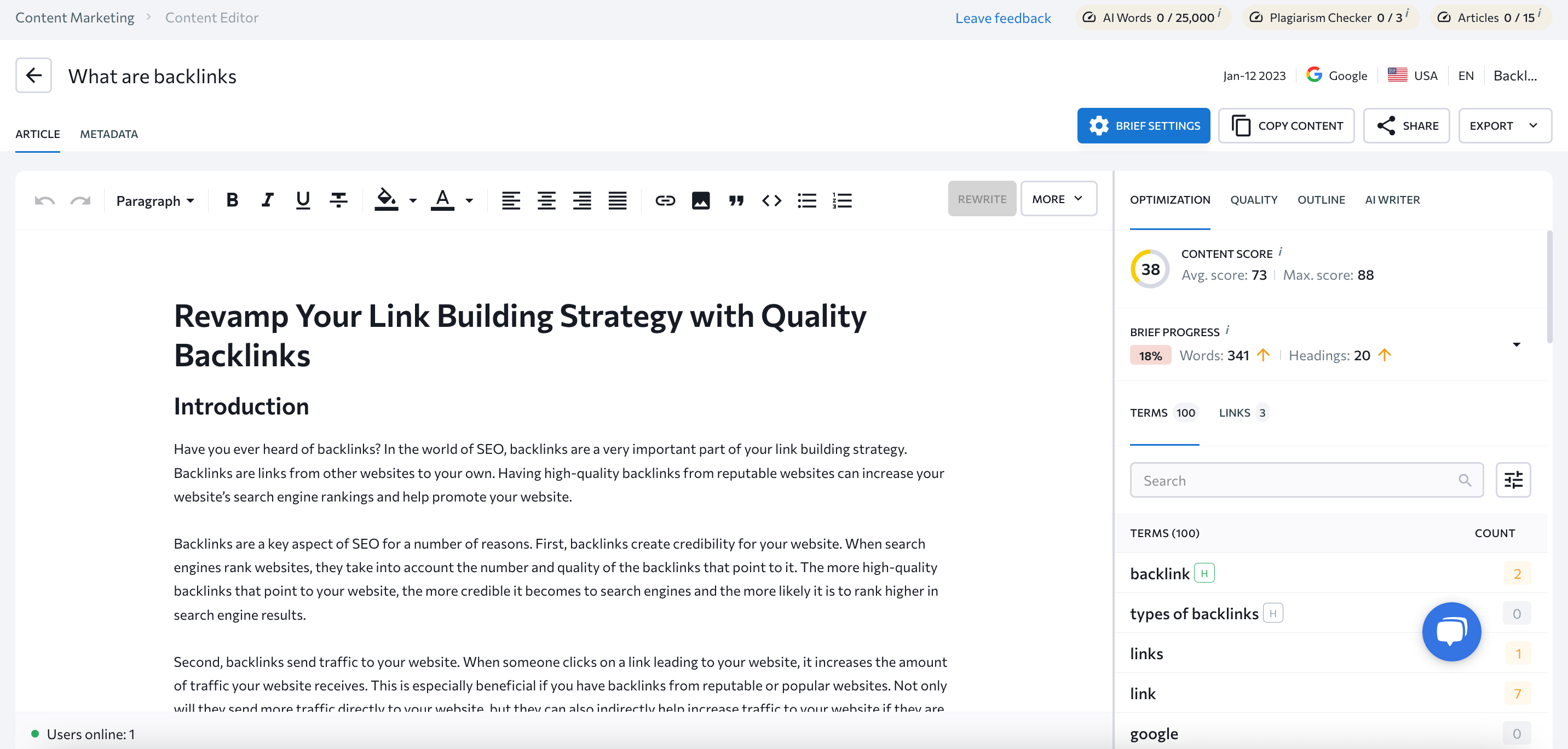
Next, receive recommendations on content improvements, including keyword usage, readability, grammar errors, and plagiarism. This instant feedback allows you to refine and optimize your content as you progress, saving time and effort.
From SEO optimization and keyword analysis to real-time content analysis and collaboration features, this tool serves as a comprehensive solution to improve your content’s quality, visibility, and search engine rankings.
Internal linking
Now, it’s time to finetune your SEO semantic writing by using internal linking, relevant anchor texts, and more.
A well-considered internal link structure will help your content show up at the right place in search.
The structure contains three elements:
- menu link structure
- breadcrumb link structure
- internal link structures in the body of the article
By linking pages together, you not only help readers navigate your site but also help Google crawl it easily and discover new pages. For example, a company that sells sneakers can have a general “sneakers” page that appears higher in search results than a “kids sneakers” page for the query “sneakers for kids”. This seems illogical. However, if the main category links to the “kids sneakers” page, it can help Google prioritize the subcategory page for the given query.
In other words, the smarter your content is linked to each other, the better effect it will have on Google and users.
When setting up internal linking, make sure that your page contains topical anchor texts.
In the HTML code of a page, an anchor text looks like this:
<a href=”https://www.example.com”>Anchor Text</a>
Let’s say your page has a lot of links with anchor text about bikes. Google will use this information to determine the topic of the page that your links point to. Here are some tips to remember while working with anchors:
- Use descriptive anchor text: Make sure it reflects the meaning of the linked page to both users and search engines.
- Incorporate long-tail keywords: This will keep things natural.
Structured data
To help Google better understand your content, use structured data—a format for classifying the content on a page. Structured data acts as a language that conveys the context behind your content to search engines. Google uses this information to display you content in a more attractive way on SERPs.
Let’s look at the AccuWeather website. The general information about their company is covered by Google’s Knowledge Graph: when it was founded, who the founder is, the customer service hotline, subsidiaries, etc.
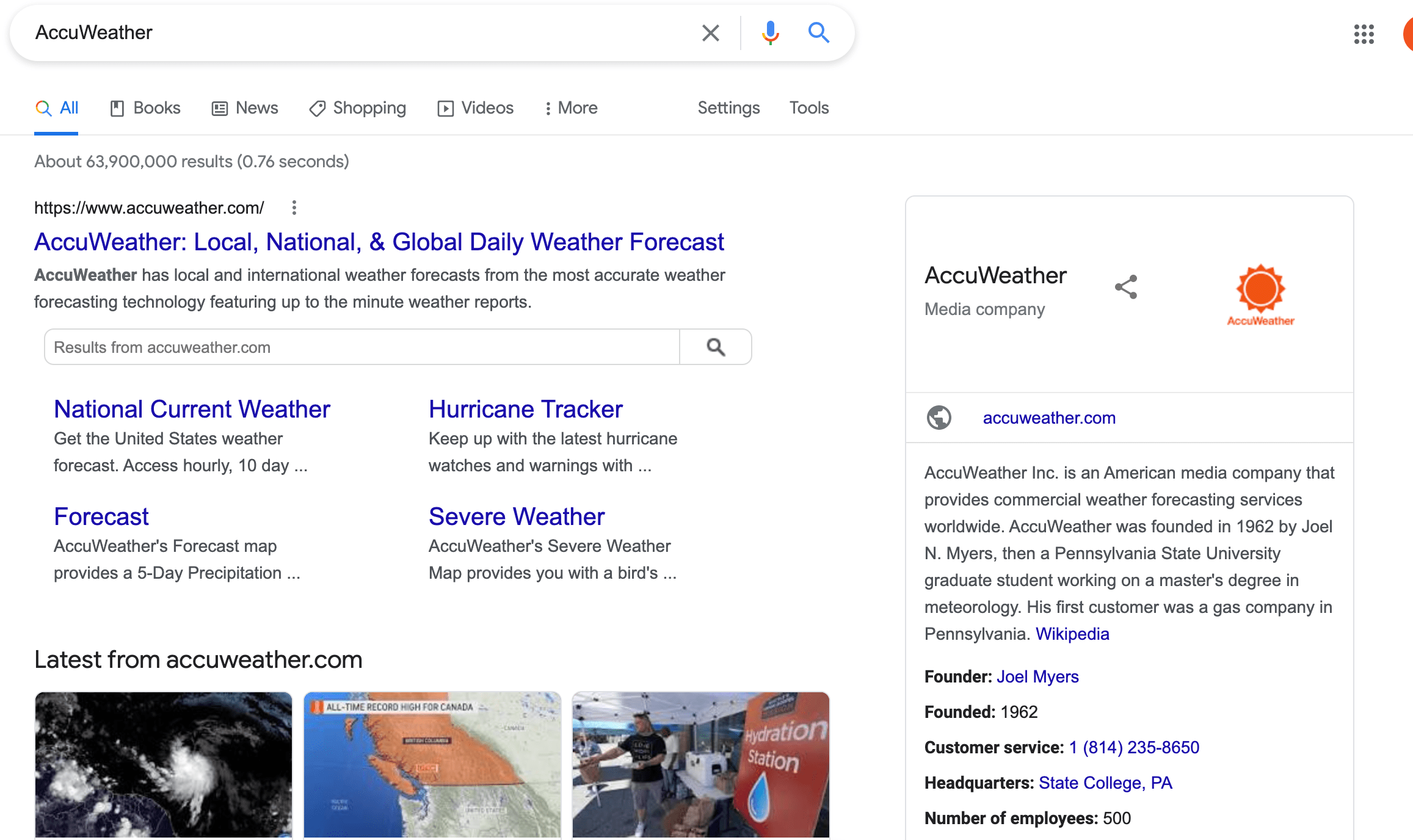
AccuWeather just helped Google understand the content of a page by including structured data.
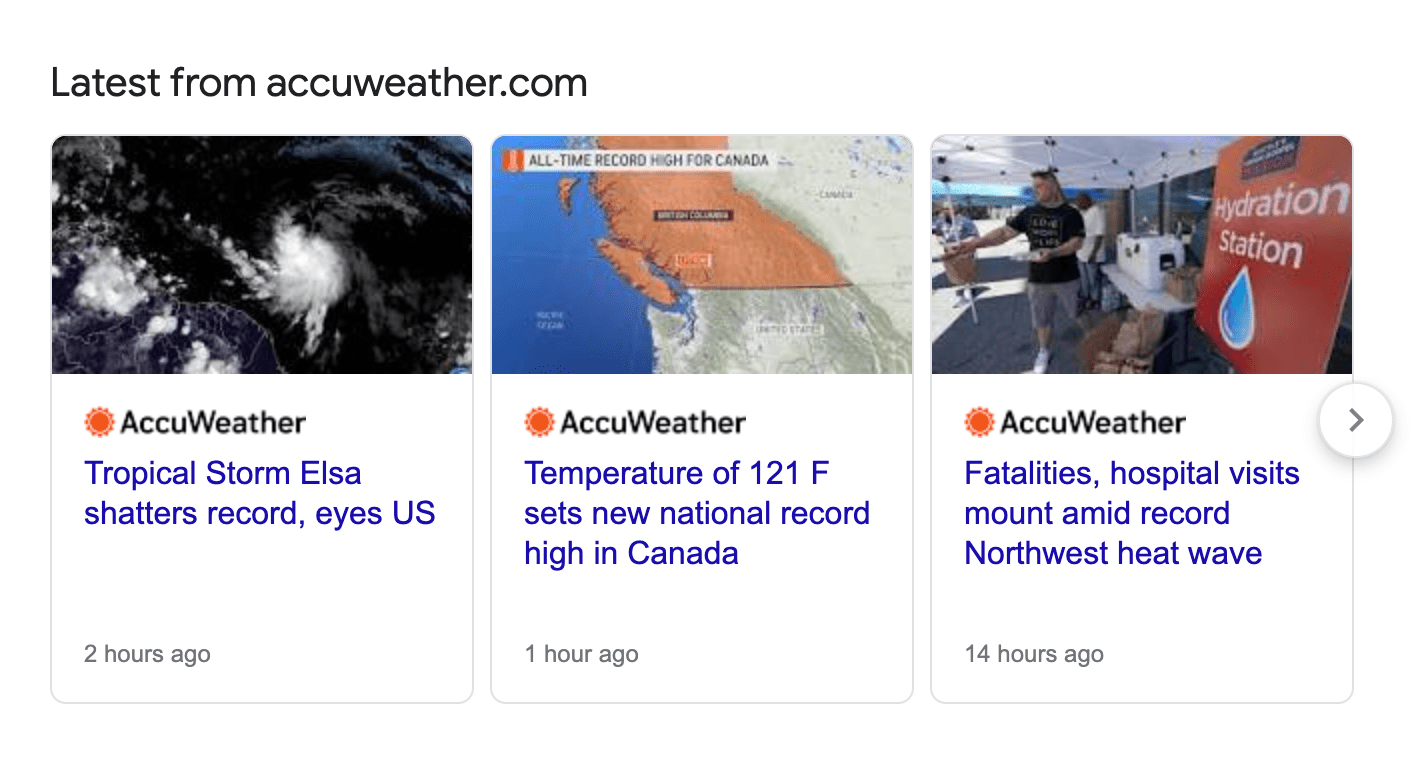
Because the structured data identifies particular elements of the weather forecasts, users can see the latest news right in the search results.
Conclusion
Creating content and optimizing it for search is all about relevance and value. Even if your page is technically flawless with some relevant keywords, it won’t rank high if the content doesn’t really cover the intended topic. The fundamentals of semantic SEO state that you must optimize your content for Google’s proper understanding of it, adapt your pages to natural language search, and answer as many related questions as you can.
- SEO Powered Content & PR Distribution. Get Amplified Today.
- PlatoData.Network Vertical Generative Ai. Empower Yourself. Access Here.
- PlatoAiStream. Web3 Intelligence. Knowledge Amplified. Access Here.
- PlatoESG. Automotive / EVs, Carbon, CleanTech, Energy, Environment, Solar, Waste Management. Access Here.
- BlockOffsets. Modernizing Environmental Offset Ownership. Access Here.
- Source: https://seranking.com/blog/semantic-seo/




